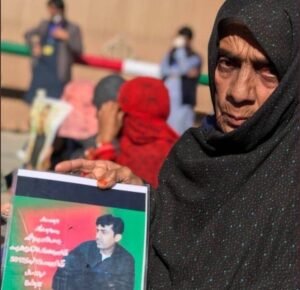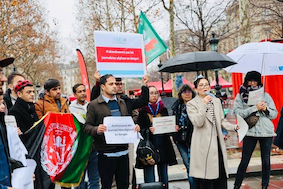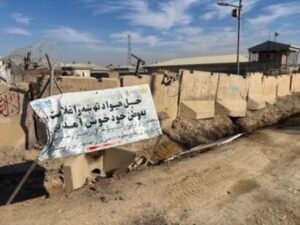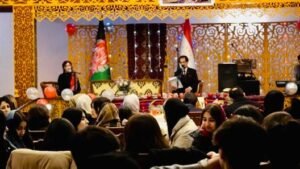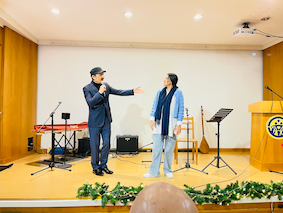Everyday Peace Indicators in Afghanistan Before the Collapse of Republic of Afghanistan (2020)

@Microsoft Bing
By Mohammad Afzal Zarghoni
ABSTRACT
The findings give us a glimpse into views and perceptions of ordinary Afghans both at a community and at a national level of the daily peace indicators. Identification of these indicators, we hope, will facilitate measurement and assessment of peace building in Afghanistan. This research is seen as the starting point for a dialogue process between target communities and the project. The only structuring impulse from our side has been the four categories of initial questions, each corresponding to a different typology of peace (negative, positive, personal and ecological).
Keywords: Everyday Peace Indicators, Afghanistan
Introduction
Afghanistan, a country embroiled in armed conflict and violence for more than four decades, has attracted sizeable scholarly attention and produced research pertaining to the causes of conflict and insurgency[1]; however, little has been done on indicators to measure peace as defined by individuals in a bottom-up approach.[2] According to the Global Peace Index (GPO),[3] and a report published by the United States Institute of Peace.[4]
Under the umbrella of the Preparing for Peace project, and with ordinary people in focus group discussions (FGD) in several provinces of Afghanistan, also conducted interviews with several individuals involved in the peace process to gather some data and assess peace indicators in a bottom-up approach. The findings give us a glimpse into the views and perceptions of ordinary Afghans both at a community and at a national level of the daily peace indicators. Identification of these indicators, we hope, will facilitate the measurement and assessment of peacebuilding in Afghanistan.
This research is seen as the starting point for a dialogue process between target communities and the project. The only structuring impulse from our side has been the four categories of initial questions, each corresponding to a different typology of peace (negative, positive, personal, and ecological).
Research Methodology
The research uses a qualitative method of semi-structured interviews. We engaged two categories of people: ordinary Afghans and elites. The inclusion of the elite category is justified because the Afghan peace process is mostly elite-led and top-down. Therefore, we needed to not only assess the perceptions of the ordinary Afghans but also understand how elites view peace. Only juxtaposing these two views would allow a holistic assessment of peace. Guided by this, we first conducted six FGDs in five provinces (Balkh, Bayman, Herat, Kabul, Kandahar); two of these FGDs were conducted virtually. The participants in FGDs consisted of male 29 and 18 females. Second, we conducted in-person interviews with nine key informants. These interviewees included a former Mujaheedeen and former Taliban commander, members of the Afghanistan peace negotiation team, members of the Ministry for Peace, and Afghan youth representatives to the United Nations.
The questionnaires used were guided within a grounded research methodology that saw our research team approaching communities and, in keeping with the inductive approach of Everyday Peace Indicators (EPI), they asked open-ended questions (in respondents’ native language) about their understanding and perception of peace. The ensuing replies were recorded, written up in English, and then grouped by frequency to provide the most common set of answers.
In what follows, the research findings are presented, and a linkage is created between the findings of this research to the categories of already developed peace indicators for Afghanistan. The links are presented through references to those categories inserted inside square brackets e.g.6
Focus Group Discussions
Kandahar
The focus group discussion in Kandahar City, held on 12 August 2020, included 9 participants 6 male and 3 female participants. Most participants agreed that peace meant an enduring ceasefire 7 across the entire country. Overall, the main indicator for respondents to signify peace was the absence of fear for their personal safety or absence of fear for their family members’ safety: absence of threats (Everyday Peace Indicators, 2013), no attacks, no explosions, no firefights between parties, no public display of weapons at community and city level, and when religious schools were not utilized for political or terrorist purposes.
For the younger respondents, peace meant creating an environment conducive for schools to remain open enabling children to attend.8 The absence of daily violence would also offer a way forward and an opportunity to build a better life.9 Because Kandahari women are to a greater extent restricted in their daily movement because of personal security (Ahmadi, et al., 2018) and the distance they need to travel between cities and villages to access services, attending educational institutions is rendered unfeasible. 10 Therefore, a reduction in threats to personal security and travel time indicates peace to them (GPI, 2000). In addition, for these respondents, building equitable opportunities and ways for exercising their rights was important. In particular, more equality in their rights with men as well as awareness of the rights of their children were emphasized. Peace for women means that they would be able to defend their rights, be self-sufficient,11 and work together with men.
To a greater degree, peace for these participants meant improving economic development, the presence of improved or improved infrastructure (GPI, 2000), the strengthening of agriculture,12 and reduced unemployment (13.3). They believe these factors bring stability to their lives.13 Reduction in poverty rates was also seen as evidence of a more peaceful community. Most participants identified that for them to have a better life, improved security, and improved implementation of the rule of law are necessary. Some respondents also suggested establishing Sharia Law 14 and providing justice to everyone would be an indicator of peace in society. Furthermore, unimpeded access to a good education system,15 and an inclusive, democratic government and systems were seen as vital for peace. In addition, having good social relations, an absence of underage marriage, and providing a suitable environment for girls’ education 16 were seen as important. Again, some religious actors indicated that peace means the reduction of non-Islamic ideologies, and therefore attention should be paid to religious schools (Madrasa) 17 as well as secular education.
Participants in Kandahar asserted that they are mostly afraid of physical violence, including assassination, the activities of local criminal groups, and firefights between them, and that these are the problems to be dealt with before they can speak of peace in their community. Provision of justice, good governance implementation of the law, ending corruption, bringing accountability, and ending discrimination are indicators that concur with peace. In the meantime, these factors need to be coupled with a strong agricultural sector, 18 a flourishing business sector, a stable electricity supply, an absence of ethnicity-based discrimination, 19 clean water and an environment, 20 industries creating jobs, developments in mining and extractive enterprises, and building schools and hospital (GPI, 2000).
Kabul
The focus group discussion in Kabul City, held on 24th of August 2020, included 9 participants, 7 male and 2 female number of participants. For these participants, the most significant peace indicators are the absence of dire poverty 21reduction in ethnic tension and discrimination, creation of jobs, good governance and working for economic development. Many of the participants expressed they were unhappy with their day-to-day experience of the current government system, current levels of everyday economic development, the education system, 22 and social justice. Currently, in Kabul, the increase in violence and criminal activity has disrupted the daily lives of the participants. These include but are not limited to kidnapping, physical violence, 23 assassinations, explosions, absence of law and order as well and the high rate of corruption.
For women in this FGD, peace meant gains in women’s rights, access to good schools and universities, 24 equal sharing in income, absence of religious prejudices in daily life, 25 security in general (Ahmadi, et al., 2018) and personal safety, and absence of suicide attacks, and absence of corruption. 26 In addition, these participants asserted that in the absence of war, they would be able to travel to other provinces 27 which means widespread peace without any fear or security problems on their journeys. Other significant factors identified are balanced economic development, access to higher education abroad, 28 and families allowing their young girls to go outside. Furthermore, the return of refugees from outside the country and going back to their villages signified peace for these participants.
Most of the respondents said that they could not openly talk about peace in their community or at a district level as they were afraid of the Taliban, organized criminal groups, and armed actors in their communities. They also identified the absence of nighttime threats, 29 government mafia, and organized criminal and drug dealer networks as signifying peace in their city and community. They believe that peace would foster a good healthcare system, 30 a strong and accessible transportation system, more jobs, justice given to all, and travel across the country.
If peace is established, people expect the following progress at the community and provincial level: agricultural development, 31 amusement parks clean environment and clean air, and peaceful relations in their communities e.g., inter-ethnic marriages. Only after establishing such a peaceful atmosphere could there be a decrease in poverty and more job opportunities, perhaps from mining and other extractive industries. According to the respondents, a concrete indicator of a functioning system would be the undisrupted provision of electricity, access to clean water and air, and lower crime rates.
Kabul University
Since Kabul is home to a large percentage of the overall population of Afghanistan, we deemed it justified to hold a separate FGD with students at Kabul University. This FGD was convened on 7th September 2020 and 8 participants 4 males, and 4 females of participants took part in it. According to the Kabul University students, peace means security, 32 , access to justice for all improved cultural security, reduction in corruption, and strong economic development. Also, they stated that the presence or absence of ethnic and personal discrimination is a main indicator. In addition, lack of trust and unity between different ethnic groups is as important an issue as poverty. Poverty and economic deprivation are believed to be the main causes of the absence of social peace in Kabul city. They also added that a ceasefire between the warring parties must be arranged soon and that having such an assurance of security would improve the following peace inductors: daily security , 33 economic development, economic freedom, ending the political crisis and bringing equality, freedom of expression, justice for women, keeping the achievements for women in the post-Taliban era, absence of fear, reduction in gender discrimination, 34 reduction in outside interference in the Afghan domestic affairs. A ceasefire may also help to create an environment in which women and men would be able to work together on an equal footing and women’s rights be respected.
For these respondents, peace would enable people to travel to different provinces within Afghanistan, 35 which is a desire shared by most Afghans, and thus experience different cultures and places. Peace would also allow people a chance to seek better education, 36 have freedom of expression, enable young girls to walk, drive, work, and raise their voices for women’s rights, etc. without fear of physical retributions or censure.
According to these respondents, Afghanistan really needs improved agriculture, 37 more and uninterrupted electricity (GPI, 2000), sound economic development, development in extractive industries such as mining (GPI, 2000), an improved education system, 38 improved and expanded roads (GPI, 2000). They hold that achieving these goals would make the country more self-sufficient and thus more independent.
Some of the participants said they were not able to talk about any indicators of peace due to the following actors currently in place creating fear: Taliban influence, armed groups, organized crime, and insurgent groups.
Herat (Virtual)
Six participants 3 male and 3 females from Herat province attended a virtual focus group discussion on the 6th September 2020. For these participants, peace meant first of all social justice, good governance, the absence of corruption, a decrease in poverty, and the creation of job opportunities. These elements include applying the law equally to everyone, balanced development, sharing political power, and a ceasefire among warring groups.
According to the female participants, peace means both women’s and youth’s rights being respected e.g., fair, and equal treatment of women in society, no overt religious extremism, access to education; 39 no kidnappings, a strong economy, and unity among all the ethnic groups.
The absence of violence would allow people to do things that they are currently unable to do. For instance, one of the recurring answers was the inability of women to travel freely to different provinces. 40 Other factors that respondents associated with peace were an investment in economic development, building more schools, 41 roads (GPI, 2000), wider access to hospitals, 42 and improvements in the telecommunication system across the county (GPI, 2000) (this seems to indicate wider areas of coverage). Women also stressed that once violence directed towards them ends, 43 they will be able to solve women’s challenges in their districts and sort out employment issues. Currently, some of them are not able to talk about peace issues due to Taliban activities (7.2), local mafia, and night threats. 44
To this group of respondents, peace means economic development and businesses will prosper, a proper justice system, and improvements in the current weak education system. 45 There will also be female doctors and teachers at the district and village levels (9.2). The health service will be improved, 46 hospitals will be built and function properly, 47household income will increase, and tourists will visit their communities. Finally, districts will be better connected as the number of roads will increase and be better maintained (GPI, 2000).
Bamiyan
The focus group discussion in Bamiyan City, held on 17th of September 2020, included 9 participants 5 male and 4 female number of participants. Bamiyan has been one of the most secure provinces of Afghanistan for the past four decades; therefore, peace for the Bamiyan participants signifies mostly highway security 48 for traveling (especially the two highways that link Bamiyan to Kabul). Other indicators included the absence of corruption, a decrease in unemployment 49 a strong economy, a reduction in poverty, and both women and children being able to exercise their rights. The participants also mentioned that a better healthcare system, 50 better roads (GPI, 2000), implementation of laws, a calm and peaceful environment, and more importantly upholding minority rights translate into peace for them.
They stated that the absence of violence would see an increase in business activity, women would be allowed to hold handicraft exhibitions, and most of them would be able to travel to other provinces safely 51 for trade exhibitions. In addition, girls and women would be given the opportunity to attend educational institutions. 52 They also remarked that if they were able to speak out against corruption and talk freely about peace within their communities it would be proof of a safer environment around them. They asserted that if people had adequate access to health services and medicine it would indicate that peace was taking root. 53 Peace was also said to mean reduced cultural barriers 54 between groups and lead to everyone’s dignity being preserved.
As individuals, women still feel threatened as there is no gender equality or justice. Many girls would like to have access to higher education outside of the country and want to stop gender discrimination made worse by poverty.
The respondents asserted that in peace their communities should experience visible economic development, and more tourists would come to visit Bamiyan pushing it towards self-sufficiency. The environment would be degraded, runoff of spoil from mining would be absent, income would increase, and infrastructure would improve visibly (GPI, 2000). These, in turn, would decrease the rate of poverty and unemployment and bring more unity and progress within the community and reduce.
Balkh (Virtual)
Six participants 4 male and 2 females from Balkh province attended a virtual focus group discussion on the 22ndSeptember 2020. To these participants, similar to other FGD participants, peace means a reduction in poverty, economic development security, and justice for all. In addition, the participants said that peace would lead to a strong education system,55 creating jobs, 56 equality, implementation of the law, and good governance, These indicators would increase a feeling of trust towards government. However, participants also pointed to the absence of empowerment of women, unbalanced development, decrease in or no employment, and lack of social justice as indicators of the absence of peace.
Participants responded that in the absence of violent schools, which were forced to close, would re-open, social justice prevail, corruption decrease, and employment opportunities increase (16.1). Plus, discrimination, in general, would disappear, the economy strengthen, a larger portion of the population would have access to education, 57 women would have the opportunities to work outside of their homes, the government establishes its authority there would be transparent elections, the law would be obeyed and enforced, men and women would be able to work together, and there would be no psychological pressure (stress) for individuals to cope with, there would be freedom of (safe) movement and women would be self-sufficient. 58
As an individual, peace would mean having a good job, 59 a good education system, 60
good roads (GPI, 2000), good schools, no kidnapping, no theft, freedom for women, their ability to leave home and travel 61 without fear, without being disturbed, and without being insulted in the community or suffering prejudice.
Participants said that in peace agriculture would be improved 62 businesses would flourish, there could be mining (GPI, 2000), factories would be established, and infrastructure (roads, schools, and water system) would improve (GPI, 2000), there would not be a shortage of food, and community would have a functioning justice system. Additionally, ethnic groups would mix in intermarriages and places of residence. 63
Some participants mentioned that they were not able to talk about peace in their community due to fear of Taliban reprisals and/or because of fear of other groups.
Key informant interviews
Our FGDs, focus was on ordinary people from all walks of life. We heard their visions for a peaceful community and society and how they perceived the presence or absence of peace therein. However, it is not a secret that the Afghan peace is elite-led and a top-down process. In order to assess their perceptions of peace, we interviewed nine individuals who are involved, in one way or another, in the ongoing peace process in Afghanistan.
For Afghan elites, indications of peace entail a ceasefire discontinuation of the current violence, 64 and equal chances for all citizens to improve their livelihoods. 65 These would further involve developing and improving social relations 66 and working towards eliminating injustice, insecurity, oppression, and violence.
Negative peace is the absence of war and all armed conflict, but without the necessary social justice, economic development, assured safety and respect of human dignity and human rights, without more equal distribution of wealth and resources, peace would be very difficult to define as merely the absence of oppression, explosions, violence, food supplies 67 and not having access to equal opportunity and development. Strong indicators of the cessation of conflict are having clean water, a strong health sector, 68 and implementing social justice for war victims.
Interviewees believe several factors contribute to the ongoing issues and absence of peace: lack of access to education, 69 lack of a good healthcare system, lack of physical freedom and mobility, the negative role of media and civil activists, poor attempts to preserve justice, lack of a conducive environment for progress and prosperity, and failure to sustain the basic needs of people within a community. 70 These factors are compounded by a lack of equal rights for all in the social system, and the continuing uncertainty spurred by the prospects of the return of the Taliban, which leave the future of human rights for Afghans in shambles and foretell of a grim future for Afghans. They consider the reduction and elimination of the following indicators as remedial: violence, including suicide bombing attacks and airstrikes, sporadic armed conflicts, bombings, and influence of local warlords, smugglers and mafia groups involved in the war. Therefore, cessation of armed conflict and violence 71 is viewed as a prerequisite for long-term and permanent peace – that is hindered by a lack of trust 72 among the main warring groups. A commitment to peace on both sides 73 will pave the way for communities to stand on their own feet, 74 the constitution will be upheld, and achievements of the last two decades regarding the current political system be preserved to provide an environment where all will have equal access to justice and equal opportunities to exercise their rights and freedoms. The absence of violence would allow the education system to improve, and more children would be able to go to school, 75 hospitals and roads would also be built (GPI,2000), and mothers would have access to essential health care.
Interviewees also mentioned that peace to them means proper accountability from the government agencies, a functioning legal system, a reasonably satisfactory life for all, 76 people would not feel anxious and fearful when family members leave home every day, 77 and people would be able to find employment in their areas of expertise and profession. 78 The theme of security was further emphasized when respondents asserted that in peace, they would be able to attend Friday prayers without the need for bodyguards or worry about attacks, religious actors would not be afraid of suicide attacks on mosques, religious scholars, who currently feel unsafe and cannot volunteer to help people out of fear of violence, would feel safer to engage their communities, and that the children of elite individuals would be safe at educational institutions.
Female respondents added that an indicator of progress, development, and growth is when women receive equal opportunities both in rural and urban areas of the country. Women regarded being able to drive in the city as an indicator of equal rights in the framework of human rights.
Some individuals noted that in a peaceful environment, they would be able to advocate for the inclusion of young people at all levels of society and decision-making by talking in public and traveling to different parts of the country without the fear of being stopped, threatened or killed, assist each other in the peace process, 79 and improve employment prospects for others. 80 They, further, noted that when peace comes it will mean that all forms of violence in their communities are completely eliminated, and tourists will come to Afghanistan.
Additionally, the respondents pointed out mostly economy-related indicators to signify peace in their communities. These included: the return of migrants to their homes and villages from outside the country and the creation of job opportunities within the country, 81 an increase in investment in local communities , 82 expansion of tourism and handicraft industries, women and men would work alongside each other improvements in agricultural practices and productivity, 83 fruits such as melons, pomegranate, grapes, bananas, dates, etc. would thrive and be exported internationally , 84 building better water management infrastructure, grazing lands and pastures would flourish and provide a good environment for livestock husbandry, 85 economic infrastructure would be restored, employment opportunities would increase, 86 connection with regional market for exhibition export of products, investment in the mining and minerals industry, exporting raw material, and an end to capital flight. They believe that economic development encourages the establishment of stable international trade that supports the establishment of democratic practices and values making peace possible and durable in their communities.
There would need to be a way to guarantee the peaceful co-existence of both Taliban and non-Taliban-focused Afghan Youth, 87 with equal opportunities for development and growth for all.
Focus Group Discussion questionnaire
- What does peace mean to you?
- What would an absence of violence allow you to do that you are currently unable to do?
- What forms of violence must be absent before we can speak about peace in your community? Please, be specific.
- What denotes the presence of peace to you?
- What kind of activities or actions would mean that peace ‘has come’ to your community?
- For you as an individual, what would peace mean in your everyday life?
- What would peace look like in your community?
- What would peace look like in your province?
Conclusion
Overall, the major indicators are the existence of a long war, lack of daily security, the existence of corruption in government, weak government, high rate of poverty, injustices, no balanced developments, high rate of migration, lack of self-sufficient economy, lack of national unity spirit, and non-implementation of law, unemployment of the people. Lack of political will to end the crisis is the main cause of crisis and war and lots of fear at the communities’ level are those indicators that everyone is suffering from it in their daily life, and these are the most violent indicators if these are not exercised it will change the situation to the peaceful environment.
Predictably, reduction in the more obvious and grosser elements of under-development is cited as a solid indicator, while overall, the major indicators of peace mentioned by the respondents are those from any extended period of conflict, i.e., any long war, with associated lack of daily security, the perceived presence of corruption at all levels of an extremely weak government.
The major complicating factor of livelihood insecurity and the correspondingly high rate of poverty are why respondents have pointed to these areas as potential indicators of peace and prosperity for them and their families. Linked to this is the high rate of out-migration to economies that are functioning, particularly important for international agencies perhaps is the indicator of return migration showing that Afghans outside the country judge the situation to be safer.
A new indicator, previously somewhat invisible to external actors, is the comment that reductions in perceived inter-ethnic tensions within society around them would also be an indicator for many Afghans of all types, i.e., if more tolerance for different groups were present. With the experience of extended periods of both national and sub-national level conflicts, crises, insecurity and the breakdown of traditional structures Afghans are very much aware of the ethnicity-linked antagonisms around them: reductions in these and the growth of a more tolerant and diverse but culturally respectful society would indicate to them a decrease in conflict.
Key Informant Interviews questionnaire
- What does negative peace mean to you?
- What would an absence of violence allow you to do that you are currently unable to do?
- What forms of violence must be absent before we can speak about peace in your community? Please be specific.
- What does positive peace mean to you?
- What denotes the presence of peace to you?
- For you as an individual, what would peace mean in your everyday life?
- What would peace allow you to do that you are unable to do now?
- What would peace look like in your community?
- What would peace look like in your province?
- What sort of developments would peace make possible in your community and province?
- Are there any specific activities, events, or developments that would cease once peace ‘comes to’ your community or province?
Declaration
Being a researcher with one of the top academic centers in 2020, I worked with the Peace Project. I was able to lead missions on my own and travel and conduct missions independently and to meet the risky provinces in order to design, collect data, and analysis of daily peace indicators in Afghanistan as well as I was part of other research projects. This study was finished just before the Republic fell and during the continuing Doha peace talks. The academic center intended to publish it, but they will be unable to do so owing to the fall of Kabul and numerous other factors. I was advised that I could post this under my own name and without citing any sources. I want to express my gratitude to my esteemed colleagues for training me and my colleagues in this research.
About the Researcher: Mohammad Afzal Zarghoni is a researcher from Afghanistan. His work focuses on peace and sustainable development goals. He is an alumna of the King Abdullah bin Abdulaziz International Center for Interreligious and Intercultural Dialog (KAICIID) International Fellows 2021. He holds a Master’s degree in Business Administration (MBA).
Zarghoni has been working in Afghanistan since 2007 with international and national organizations in the field of social science research, education, peace, human rights, and information science. He has an overview about Afghanistan’s recent and earlier historical sources and events. His combined breadth of experience makes him well-placed to be a benefit to and benefit from relevant programs.
Mohammad Afzal Zarghoni Alumni of King Abdullah bin Abdulaziz International Centre for Interreligious and Intercultural Dialogue (KAICIID)
Note: The contents of the article are of sole responsibility of the author. Afghan Diaspora Network will not be responsible for any inaccurate or incorrect statement in the articles.

